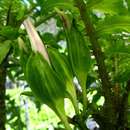Biology
(
Inglês
)
fornecido por Arkive
As a recent discovery, little is currently known about the biology of Cyanea magnicalyx (3).
Conservation
(
Inglês
)
fornecido por Arkive
Hawaii's Comprehensive Wildlife Conservation Strategy lists Cyanea magnicalyx as a “Species of Greatest Conservation Need” (4). Currently, significant efforts are being made to preserve this species. In the wild, weed control is being used in the vicinity of the remaining individuals (5), and they are continuously monitored for threats such as disease or insect damage (3). In addition, using material from wild Cyanea magnicalyx, cultivated plant stocks are being established, which will be used to expand existing populations of Cyanea magnicalyx, and to introduce new populations to safer habitats (3) (5).
Description
(
Inglês
)
fornecido por Arkive
Discovered as recently as 2004, this extremely rare species is, as of 2008, only known from fewer than ten individuals. Cyanea magnicalyx is a relatively large, tree-like shrub, which can reach up to three metres in height. Its long, shiny green leaves, though superficially resembling palm fronds, have a more unusual shape. The base of the leaf is divided into opposite pairs of elongated leaflets, which branch from either side of the central stem, but towards the end of the leaf, the leaflets become partially fused. Cyanea magnicalyx produces striking yellowish-white flowers striped with purple, which are borne on stalks connected to a central stem called a raceme. A single raceme can bear as many as 15 flowers which, after fertilisation, develop into large, bright yellow berries (3).
Habitat
(
Inglês
)
fornecido por Arkive
Cyanea magnicalyx is found in moist forests at elevations of around 500 metres (3).
Range
(
Inglês
)
fornecido por Arkive
Cyanea magnicalyx is endemic to the Hawaiian island of Maui, where it is known from a small number of localities in the western region of the island (3).
Status
(
Inglês
)
fornecido por Arkive
Not yet assessed by the IUCN (2)
Threats
(
Inglês
)
fornecido por Arkive
Although Cyanea magnicalyx has not yet been assessed by the IUCN, because of its tiny population, it is in an extremely vulnerable position. Within its limited range, numerous threats to this species exist, such as damage from feral pigs, predation of its fruit by rats, and competition from invasive plant species. These biological factors, in combination with the threat of floods and landslides, mean that the extinction of this species is a very real possibility (3).

